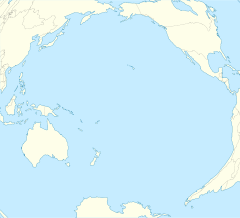1808 mystery eruption
The 1808 mystery eruption is one or potentially multiple unidentified volcanic eruptions that resulted in a significant rise in stratospheric sulfur aerosols, leading to a period of global cooling analogous to the Year Without a Summer in 1816.[2][3][4]
Background
Until the 1990s, climatologists considered the known deterioration of the weather in the early 1810s as a normal phenomenon of the Little Ice Age. A 1991 study of Antarctic and Greenland ice cores, however, found a sulfate spike in early 1809, roughly half that of the 1815 eruption of Mount Tambora.[5] This faced volcanologists with the problem that this period has no recorded eruptions of the needed magnitude to generate such a spike.[6] Further research and bristlecone pine tree ring data pointed to the eruption being in 1808 rather than early 1809.[7]
Initially believed to be a single VEI-6 eruption, emerging evidence suggests that the rise in sulfate concentration and global cooling was likely caused by a series of eruptions, including some minor ones.[8][2][9]
Location and date
Compilations of the geochemistry of
The analysis of sulfur isotopes shows a complex time-evolving pattern, suggesting multiple eruptions that caused the 1809 sulfate layer and global cooling, consistent with the presence of different geochemical tephra populations during this period.[9]
The expectation that any eruptions of that magnitude should have been noticed at the time added to the mystery. Records from the time throughout the world were checked but nothing appeared viable until the summer of 2014, when PhD student Alvaro Guevara-Murua and Caroline Williams of the University of Bristol discovered an account of atmospheric events consistent with such an event by Colombian scientist Francisco José de Caldas.
Caldas served as Director of the Astronomical Observatory of Bogotá between 1805 and 1810 and in 1809 reported a "transparent cloud that obstructs the sun's brilliance" at Bogotá. It had first been observed by him on 11 December 1808 and was visible across Colombia.[4] The cloud might have been a "dry fog", which is a sulfuric acid (H2SO4) aerosol.[4] He also reported that the weather had been unusually cold, with frosts.
To the south, in
The south-western
Known significant eruptions in 1808
In 1808 there were major eruptions in
The Chilean
See also
- 1257 Samalas eruption, previously a mystery eruption
- 1458 mystery eruption
- 1452/1453 mystery eruption
- List of large volcanic eruptions of the 19th century
References
- .
- ^ S2CID 181849906.
- Science Daily. University of Bristol. Retrieved 26 September 2015.
- ^ .
- ISSN 0148-0227.
- doi:10.1029/91jd01634. Archived from the originalon 27 September 2012. Retrieved 16 December 2014.
- S2CID 14654597.
- ^ ISSN 0094-8276.
- ^ a b Will Hutchison; Andrea Burke; Patrick Sugden; Siwan Davies; Michael Sigl (2023). "Re-evaluating the source, style and impacts of the 1800–1835 eruption cluster with new ice core isotope and cryptotephra analyses". PAGES Volcanic Impacts on Climate and Society 5th Workshop.
- ISBN 978-1-922144-22-5(pbk.) 9781922144232 (eBook)
- S2CID 247550313.
- ^ http://www.volcanolive.com/savo.html Savo - Toghavitu Eruption. Retrieved 24 November 2015
- ^ Knittel, Ulrich (1999). "History of Taal's Activity to 1911 as Described by Fr. Saderra Maso". Institut für Mineralogie und Lagerstättenlehre, RWTH Aachen University. Archived from the original on 1 May 2018. Retrieved 26 September 2015.
- ^ "1809: The missing volcano". www.volcanocafe.org. 25 January 2016. Retrieved 24 April 2018.

